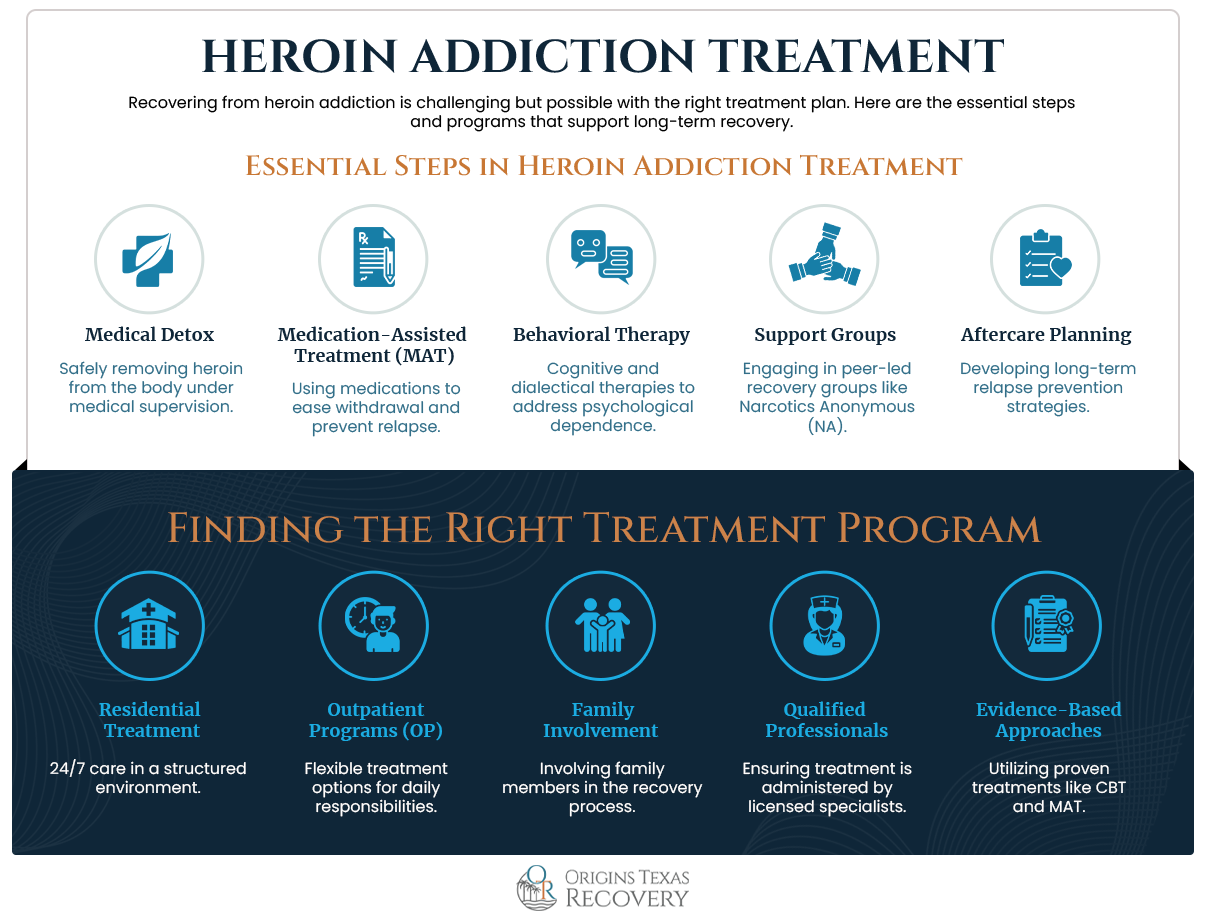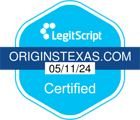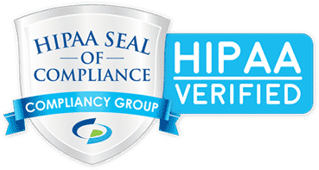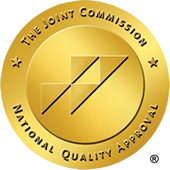Heroin Addiction Treatment
- The number of Americans who die from heroin overdose every year–14,000
- The number of Americans who use heroin every year–902,000
- The number of Americans who will use heroin during their lifetime–6,250,000
- 80% of people who use heroin started by misusing prescription opioids
Fortunately, there is effective treatment for opioid addiction at our heroin addiction treatment center in South Padre Island, TX.

What is Heroin?
Why is Heroin So Addictive?
Heroin is extremely addictive because it changes the chemicals in the brain. Often, heroin users will develop a tolerance for the drug. This means that they feel the need for more and more of the drug to experience the high they used to get initially. The more they use, the more they need to use.
How It Works
Heroin is an opioid that binds to the receptors in the brain that release the feel-good hormone, dopamine. Regardless of how you consume heroin, it gets to the brain quickly. This increases the activity of the pleasure pathway by increasing dopamine transmission, which plays a part in how we experience pleasure and pain.
Regular users usually develop a tolerance as discussed above. Still, most people who use heroin are aware of the risks but are unable to stop using it. This is what makes a professional heroin addiction treatment center so important for long-term recovery.
Signs of Heroin Addiction
- Drowsiness or restlessness
- Slurred speech
- Pinpoint pupils
- Depression
- Memory issues
- Needle marks (if injecting)
- Nose sores or runny nose (if snorting it)
- Constipation
- Decreased perception of pain
- Changes in physical appearance or decline in personal hygiene
- Aggressive or secretive behavior
- Missing money or needing more without a logical reason
- Difficulties in school or at work
- Risky or dangerous behavior
- Increasing tolerance for the drug
Common short-term effects of heroin abuse include:
- Warm skin flushing
- Dry mouth
- Nausea and vomiting
- Feeling heaviness in arms and legs
- Itching
- Confused mental functioning
- Going “on the nod,” a state of going in and out of consciousness
The use of heroin over a long period includes these effects:
- Insomnia
- Kidney and liver disease
- Collapsed veins
- Complications of lung functioning
- Mental disorders such as antisocial personality disorder and depression
- Sexual dysfunction in men
- Irregular menstrual cycles in women
Contact Our Admissions Team Today
Heroin Withdrawal Symptoms
Expect these symptoms within the first 24 hours after quitting.
- Muscle aches
- Restlessness
- Anxiety
- Extreme sweating
- Insomnia
- Runny nose
- Frequent yawning
More severe symptoms appear after the first 24 hours including:
- Cramping
- Nausea and vomiting
- Diarrhea
- Goosebumps
- Increased heartbeat
- Elevated blood pressure
- Blurry vision
- Dilated pupils
Withdrawal symptoms tend to diminish within 72 hours. The more severe symptoms can be managed with hospitalization and medication.
Testimonials
![]()
![]()
![]()
![]()
![]()
Victoria H
I couldn’t recommend Origins more, I first attended their IOP program, then their residential program in South Padre. I’m writing this today a year and a half sober and going strong. Origins has literally saved my life in more ways than one.
![]()
![]()
![]()
![]()
![]()
Emily W
The clinicians are knowledgeable and skilled in a way that is always helpful and never harmful. This program brought me lasting healing and freedom.
![]()
![]()
![]()
![]()
![]()
Mary L
I cannot say enough about Hannah’s House. I entered broken, tired and far more sick than I realized. I was treated with kindness, love, patience and respect by all. I was so frightened to go but sad to leave, that speaks volumes. Thank you from the bottom of my heart to all who put me back together, I am eternally grateful.
![]()
![]()
![]()
![]()
![]()
Jack W
I struggled with my sobriety for over 5 years, but they were able to help me through the 12 steps of AA. I have been sober ever since my experience here. I’ll be hitting 2 years of sobriety in 22 days, thanks to this treatment center. No matter where you go, it’s all about your level of commitment towards gaining a better life ?
![]()
![]()
![]()
![]()
![]()
Jazmine R
Origins was exactly what I needed. The staff were incredibly knowledgeable, compassionate, and helpful. They come with years of experience and consider each individual they’re helping. If you’re looking for a facility that will truly care as much as you/your parents do, or are desperate for a miracle — I can’t recommend Origins more! ❤️
The Opioid Epidemic in Texas
What are Opioids?
Opioids are a class of drugs that come directly from or mimic the natural substances found in the opium poppy plant. They include synthetic opioids and are available legally by prescription, such as
- oxycodone,
- hydrocodone,
- codeine, and
- morphine.
Opioids also include the illegal drug heroin, among others. In 2022, the CDC reported the drug-related death rate in Texas at 9.7. This accounts for 2,601 deaths. Although that’s lower than the national average, the steady increase shows a growing public health issue. Opioid-related statistics include:
- 3,172 opioid overdose deaths in 2022, an increase from 1,402 opioid overdose deaths in 2018
- Opioid overdose deaths account for 58% of all overdose deaths
- Prescription opioids are involved in 39% of opioid overdose deaths
- Heroin is involved in almost half of opioid deaths

Treatment for Heroin Addiction
For most people, attempting to stop and then failing makes them feel worse about themselves. It’s important to understand that they aren’t the problem. Severe withdrawal symptoms can set in quickly and cause many people to give up repeatedly.
For this reason, a professionally monitored detox center is the best and safest way to go through withdrawal from heroin or any opioid. Detox rids your body of toxins and physical dependence. This prepares you to begin treatment for your behavioral dependence without the cravings that can derail recovery.
The medications commonly used to treat heroin addiction work by binding to the same opioid receptors that heroin does. However, they are less likely to promote the harmful behaviors of a heroin use disorder. Three types of medications are typically used:
- Agonists: Agonists activate the same brain receptors. Methadone is a slow-acting agonist and is available only in approved programs. Also in this class is the drug Lofexadine.
- Partial agonists: Partial agonists also activate the same brain receptors but they only provide a limited response. Buprenorphine is one such drug.
- Antagonists: Antagonist drugs, such as Naltrexone, block the brain receptors and prevent the rewarding sensations of opioids.
Many behavioral therapies have shown their effectiveness for heroin addiction. They are effective in both outpatient and residential programs. They include:
- Cognitive Behavioral Therapy (CBT): CBT helps individuals recognize their dysfunctional thinking patterns and expectations as they relate to drug use.
- Dialectical Behavior Therapy (DBT): DBT is a form of CBT but is more focused on emotional growth and understanding, learning to accept yourself but seeking change.
- Group and Individual Therapy: Whether one-on-one with a therapist, or in a group of peers, these approaches help participants recognize their triggers for drug use and underlying issues that might be causing emotional upheaval.
Residential Treatment: This is considered the highest level of care. In a residential treatment program, the individual lives at the treatment facility and receives round-the-clock care and monitoring. By living at the facility, they are in a safe, drug-free environment, away from the triggers that might stimulate cravings.
Outpatient Programs (OP): In an outpatient program, the patient may attend treatment sessions several times a week or only once a week, depending on the appropriate outpatient treatment level.

Finding the Right Heroin Rehab Center
- Assessment and Treatment Matching
Finding help begins with reliable screening and assessment of any related conditions and the availability of programs necessary. - Integrated Treatment Approach
Treating any co-occurring psychiatric conditions. - Continuing care
Continuing care provides essential social support and support services after leaving rehab. - Respectful environment
A respectful, professional environment helps patients regain self-respect. - Family involvement
Family involvement helps educate family members about addiction. - Use of Evidence-Based Treatments like CBT
- Qualified Staff
- Personalized Approaches
This may include gender-specific, LGBTQ, or other specialized populations. - Valid Measurement of Outcomes
Quality programs reassess individuals through the duration of the program. - Quality programs reassess individuals through the duration of the program.
Nationally Recognized & Accredited





Break the Cycle of Drug Addiction at Origins Texas
Our detox center provides a safe place to go through the pain and discomfort of withdrawal with medical supervision. Our therapists are addiction specialists, trained and licensed in therapeutic approaches including family and trauma therapy.
If you’re struggling, or someone you love is suffering, Origins Texas can help you break the cycle of drug addiction–quit, crave, and start again, and on and on. Break out and make the most important call of your life. Contact us today.









